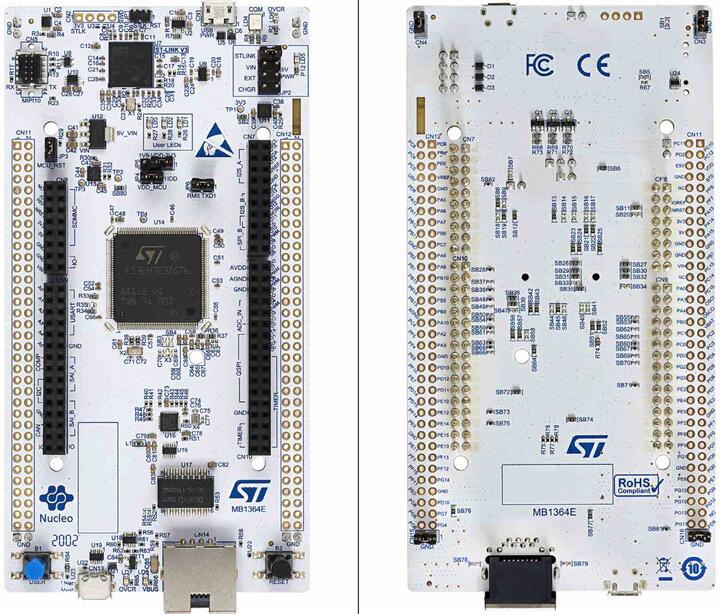ST Nucleo H723ZG
Overview
The STM32 Nucleo-144 board provides an affordable and flexible way for users to try out new concepts and build prototypes by choosing from the various combinations of performance and power consumption features, provided by the STM32 microcontroller. For the compatible boards, the internal or external SMPS significantly reduces power consumption in Run mode.
The ST Zio connector, which extends the ARDUINO® Uno V3 connectivity, and the ST morpho headers provide an easy means of expanding the functionality of the Nucleo open development platform with a wide choice of specialized shields. The STM32 Nucleo-144 board does not require any separate probe as it integrates the ST-LINK V3 debugger/programmer.
The STM32 Nucleo-144 board comes with the STM32 comprehensive free software libraries and examples available with the STM32Cube MCU Package.
Key Features
STM32 microcontroller in LQFP144 package
Ethernet compliant with IEEE-802.3-2002 (depending on STM32 support)
USB OTG or full-speed device (depending on STM32 support)
3 user LEDs
2 user and reset push-buttons
32.768 kHz crystal oscillator
Board connectors:
USB with Micro-AB
Ethernet RJ45 (depending on STM32 support)
SWDST Zio connector including Arduino* Uno V3ST
ST morpho expansion
Flexible power-supply options: ST-LINK USB VBUS or external sources
External or internal SMPS to generate Vcore logic supply
On-board ST-LINK/V3 debugger/programmer with USB re-enumeration
capability: mass storage, virtual COM port and debug port
USB OTG full speed or device only

More information about the board can be found at the Nucleo H723ZG website.
Hardware
Nucleo H723ZG provides the following hardware components:
STM32H723ZG in LQFP144 package
ARM 32-bit Cortex-M7 CPU with FPU
Chrom-ART Accelerator
Hardware JPEG Codec
550 MHz max CPU frequency
VDD from 1.62 V to 3.6 V
1 MB Flash
562 kB SRAM max (376 kb used currently)
High-resolution timer (2.1 ns)
32-bit timers(2)
16-bit timers(12)
SPI(6)
I2C(4)
I2S (3)
USART(4)
UART(4)
USB OTG Full Speed and High Speed(1)
USB OTG Full Speed(1)
CAN FD(2)
SAI(2)
SPDIF_Rx(4)
HDMI_CEC(1)
Dual Mode Quad SPI(1)
Camera Interface
GPIO (up to 114) with external interrupt capability
16-bit ADC(3) with 36 channels / 3.6 MSPS
12-bit DAC with 2 channels(2)
True Random Number Generator (RNG)
16-channel DMA
LCD-TFT Controller with XGA resolution
Supported Features
The Zephyr nucleo_h723zg board configuration supports the following hardware features:
Interface |
Controller |
Driver/Component |
|---|---|---|
NVIC |
on-chip |
nested vector interrupt controller |
UART |
on-chip |
serial port |
PINMUX |
on-chip |
pinmux |
GPIO |
on-chip |
gpio |
RTC |
on-chip |
counter |
I2C |
on-chip |
i2c |
SPI |
on-chip |
spi |
PWM |
on-chip |
pwm |
ETHERNET |
on-chip |
ethernet |
RNG |
on-chip |
True Random number generator |
Backup SRAM |
on-chip |
Backup SRAM |
RTC |
on-chip |
rtc |
Other hardware features are not yet supported on this Zephyr port.
The default configuration can be found in the defconfig files: boards/st/nucleo_h723zg/nucleo_h723zg_defconfig
For more details please refer to STM32 Nucleo-144 board User Manual.
Default Zephyr Peripheral Mapping:
The Nucleo H723ZG board features a ST Zio connector (extended Arduino Uno V3) and a ST morpho connector. Board is configured as follows:
UART_3 TX/RX : PD8/PD9 (ST-Link Virtual Port Com)
USER_PB : PC13
LD1 : PB0
LD2 : PB7
LD3 : PB14
I2C : PB8, PB9
SPI1 NSS/SCK/MISO/MOSI : PD14PA5/PA6/PB5 (Arduino SPI)
System Clock
Nucleo H723ZG System Clock could be driven by an internal or external oscillator, as well as the main PLL clock. By default, the System clock is driven by the PLL clock at 550MHz, driven by an 8MHz high-speed external clock.
Serial Port
Nucleo H723ZG board has 4 UARTs and 4 USARTs. The Zephyr console output is assigned to UART3. Default settings are 115200 8N1.
Backup SRAM
In order to test backup SRAM you may want to disconnect VBAT from VDD. You can
do it by removing SB52 jumper on the back side of the board.
Programming and Debugging
Currently the nucleo_h723zg board supports stm32cubeprogrammer (default), OpenOCD and J-Link debuggers.
Note
Official OpenOCD support for this board was added on October ‘20. Make sure your openocd version is older than that. Following links may be helpful: OpenOCD installing Debug Version and OpenOCD installing with ST-LINK V3 support
Note
Check if your ST-LINK V3 has newest FW version. It can be done with STM32CubeIDE
Flashing
Nucleo H723ZG board includes an ST-LINK/V3 embedded debug tool interface.
First, connect the NUCLEO-H723ZG to your host computer using the USB port to prepare it for flashing. Then build and flash your application.
Here is an example for the Hello World application.
Run a serial host program to connect with your NUCLEO-H723ZG board.
$ minicom -b 115200 -D /dev/ttyACM0
or use screen:
$ screen /dev/ttyACM0 115200
Build and flash the application:
# From the root of the zephyr repository
west build -b nucleo_h723zg samples/hello_world
west flash
You should see the following message on the console:
$ Hello World! nucleo_h723zg
Blinky example can also be used:
# From the root of the zephyr repository
west build -b nucleo_h723zg samples/basic/blinky
west flash
Debugging
You can debug an application in the usual way. Here is an example for the Hello World application.
# From the root of the zephyr repository
west build -b nucleo_h723zg samples/hello_world
west debug
